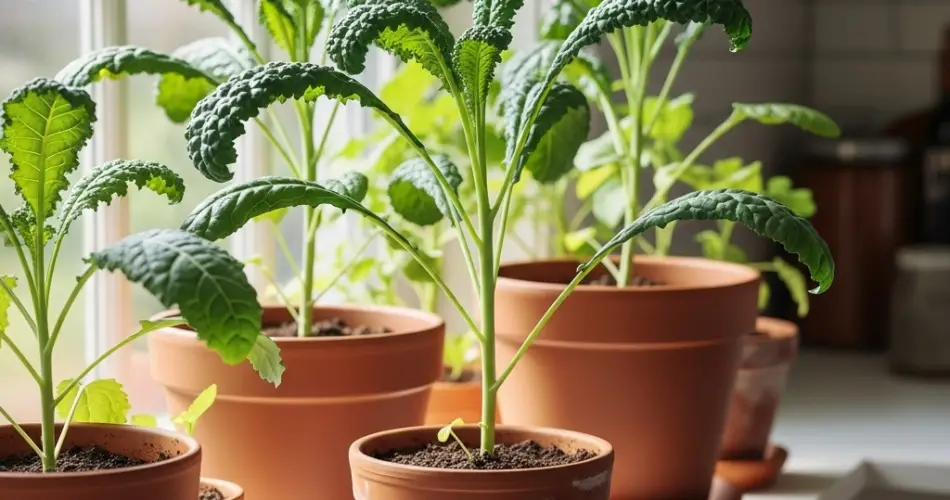Don’t have a backyard? No problem. You can still enjoy the benefits of homegrown kale right from your balcony, patio, or windowsill. Kale is a hardy leafy green that grows exceptionally well in pots, making it ideal for urban gardeners and those with limited space. Not only is kale easy to grow, but it also provides a steady supply of nutritious leaves that can be used in salads, smoothies, stir-fries, and soups.
This guide will walk you through the simple process of growing kale in pots—from choosing the right variety to harvesting your first homegrown greens.
Why Kale is Ideal for Container Gardening
Kale is one of the most beginner-friendly crops you can grow in a container. Here’s why it stands out:
-
Compact growth: Kale doesn’t need much space to flourish.
-
Cold tolerance: Grows well in cool weather and can survive light frosts.
-
Continuous harvest: Pick a few leaves at a time and keep the plant producing.
-
Nutrient-rich: Packed with vitamins A, C, K, calcium, and fiber.
-
Low maintenance: With basic care, it thrives in pots just as well as in the ground.
If you’re looking for a productive and rewarding plant for your container garden, kale is an excellent choice.
Choosing a Kale Variety for Pots
While most kale varieties can be grown in containers, some are particularly well-suited to small spaces and container growing habits.
Top choices include:
-
‘Dwarf Blue Curled’ – Compact and curly, perfect for pots and small planters.
-
‘Lacinato’ (Dinosaur Kale) – Long, dark green leaves with a rugged texture.
-
‘Red Russian’ – Flat, tender leaves with purple stems; sweet flavor and fast growth.
-
‘Siberian’ – Very hardy and cold-tolerant; great for extended seasons.
Choose dwarf or compact types if your growing space is limited. If you want more variety, mix a few types in a larger container for a colorful and flavorful harvest.
The Right Container for Growing Kale
Kale needs enough room for roots to grow and space around the plant for air circulation.
Container recommendations:
-
Depth: At least 8–10 inches deep
-
Diameter: 12 inches or more for a single plant
-
Material: Plastic pots, clay pots, grow bags, or even repurposed containers with holes
-
Drainage: Essential—ensure your pot has drainage holes to prevent water buildup
You can grow one kale plant per 12-inch pot or several in a rectangular planter spaced 8–10 inches apart.
Best Soil for Kale in Containers
Kale prefers rich, loose, and well-draining soil with plenty of organic matter. The goal is to keep roots moist but not waterlogged.
Recommended mix:
-
2 parts high-quality potting soil
-
1 part compost or aged manure
-
Optional: Add perlite or coarse sand to improve drainage and airflow
Before planting, moisten the soil so it’s damp but not soaked. Avoid using garden soil in containers, as it can compact and hinder drainage.
Planting Kale in Pots
You can grow kale either from seeds or seedlings.
From seeds:
-
Sow seeds ½ inch deep, spacing them 4–6 inches apart.
-
Keep the soil evenly moist until germination (usually within 7–10 days).
-
Thin seedlings once they have a few true leaves, leaving the healthiest ones.
From seedlings:
-
Dig a small hole and plant the seedling so the base of the stem is level with the soil.
-
Gently firm the soil around the plant and water thoroughly.
If starting indoors, use a sunny windowsill or a grow light until the plants are strong enough for outside placement.
Sunlight and Temperature Requirements
Kale grows best in cool weather and prefers full sun, though it can tolerate partial shade.
-
Light: 6 or more hours of sunlight daily is ideal.
-
Temperature: Best between 45°F and 75°F (7°C to 24°C). It can handle light frosts, which often improve its flavor.
-
In hot climates: Provide afternoon shade or plant in cooler months to avoid bolting.
Rotate pots as needed to ensure even sun exposure and healthy leaf growth.
Watering and Feeding Your Kale
Kale needs consistent moisture to produce tender, flavorful leaves.
Watering tips:
-
Water when the top inch of soil feels dry.
-
Avoid letting the soil dry out completely, especially during warm weather.
-
Ensure excess water can drain freely from the container.
Fertilizer:
-
Feed with a balanced liquid fertilizer every 2–3 weeks.
-
Alternatively, top-dress with compost or use a slow-release organic fertilizer.
Too much nitrogen can lead to overly leafy plants with reduced flavor, so keep feeding moderate.
Harvesting Kale from Pots
You can start harvesting kale once the leaves are 4–6 inches long. Use clean scissors or your hands to pick the outer leaves first.
Harvest tips:
-
Leave the central growing point intact to allow new leaves to grow.
-
Regular harvesting encourages continuous production.
-
Avoid waiting too long to harvest, as older leaves can become tough or bitter.
If your plant starts to bolt (produce flowers), harvest the remaining leaves quickly—they will become less tasty afterward.
Troubleshooting Common Problems
-
Yellowing leaves: Often due to overwatering or nutrient deficiencies.
-
Pests: Aphids, cabbage worms, and slugs are common—remove them by hand or use organic sprays like neem oil.
-
Bolting: Triggered by hot weather—try planting earlier or later in the season.
Keep your plant healthy with regular checks and by removing damaged or yellow leaves.
Final Thoughts
Kale is one of the most forgiving and productive leafy greens you can grow in a container. It doesn’t need a yard, and it doesn’t require much experience. With the right pot, good soil, and proper care, you’ll enjoy a steady supply of fresh kale for months.
Whether you’re growing on a balcony, porch, or sunny kitchen ledge, kale offers a simple and nutritious way to start your gardening journey—even without a traditional garden space.



